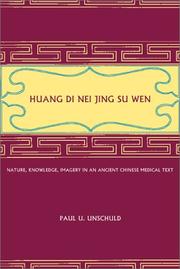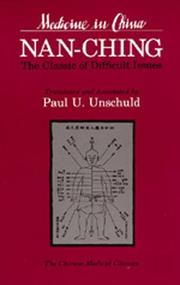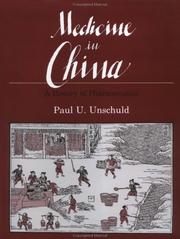| Listing 1 - 10 of 35 | << page >> |
Sort by
|
Book
ISBN: 0520965833 9780520965836 9780520292277 0520292278 Year: 2016 Publisher: Berkeley, CA : University of California Press,
Abstract | Keywords | Export | Availability | Bookmark
 Loading...
Loading...Choose an application
- Reference Manager
- EndNote
- RefWorks (Direct export to RefWorks)
This newly revised and updated edition of Paul U. Unschuld's original 1986 groundbreaking translation reflects the latest philological, methodological, and sinological standards of the past thirty years. The Nan Jing was compiled in China during the first century C.E., marking both an apex and a conclusion to the initial development stages of Chinese medicine. Based on the doctrines of the Five Phases and yinyang, the Nan Jing covers all aspects of theoretical and practical health care in an unusually systematic fashion. Most important is its innovative discussion of pulse diagnosis and needle treatment. This new edition also includes selected commentaries by twenty Chinese and Japanese authors from the past seventeen centuries. The commentaries provide insights into the processes of reception and transmission of ancient Chinese concepts from the Han era to the present time. Together with the Huang Di Nei Jing Su Wen and the Huang Di Nei Jing Ling Shu, this new translation of the Nan Jing constitutes a trilogy of writings offering scholars and practitioners today unprecedented insights into the beginnings of a two-millennium tradition of what was a revolutionary understanding of human physiology and pathology.
Medicine, Chinese --- Bianque, --- Pien-chʻüeh, --- Nan jing (Bianque) --- Huang di ba shi yi nan jing (Bianque) --- Nan ching (Pien-chʻüeh) --- 1986. --- academic research. --- academic. --- ancient china. --- ancient world. --- anthology. --- china. --- chinese culture. --- chinese medicine. --- chinese translation. --- doctrine. --- eastern medicine. --- eastern philosophy. --- essays. --- first century. --- five phases. --- han era. --- health care. --- medical professional. --- medical text. --- medical texts. --- methodology. --- modern world. --- nan jing. --- needles. --- pathology. --- philosophy. --- physiology. --- practical. --- pulse. --- research. --- revised. --- scholarly. --- translation. --- updated. --- yinyang.
Book
ISBN: 0520965825 9780520965829 9780520292253 0520292251 Year: 2016 Publisher: Berkeley, CA : University of California Press,
Abstract | Keywords | Export | Availability | Bookmark
 Loading...
Loading...Choose an application
- Reference Manager
- EndNote
- RefWorks (Direct export to RefWorks)
The Ling Shu, also known as the Ling Shu Jing, is part of a unique and seminal trilogy of ancient Chinese medicine, together with the Su Wen and Nan Jing. It constitutes the foundation of a two-thousand-year healing tradition that remains active to this day. Its therapeutic approach is based on a purely secular science of nature, with natural laws serving as guidelines for human behavior and medical treatment. No other text offers such broad insights into the thinking and manifest action of the authors of the time. Following an introduction, this volume contains the full original Chinese text of the Ling Shu, an English translation of all eighty-one chapters, and notes on difficult-to-grasp passages and possible changes in the text over time on the basis of Chinese primary and secondary literature of the past two thousand years and translator Paul Unschuld's own work. The Ling Shu reveals itself as a completely rational work, and, in many of its statements, a surprisingly modern one. It will provide the foundation for comparisons with the nearly contemporaneous Corpus Hippocraticum of ancient Europe and today's iterations of traditional Chinese Medicine as well.
Medicine, Chinese. --- Chinese medicine --- TCM (Medicine) --- Traditional Chinese medicine --- Traditional medicine --- Ling shu jing. --- Ling shu ching --- Huang-ti nei ching ling shu --- Kōtei naikei reisū --- Reisūkei --- Nei jing ling shu --- Ling shu --- Ling chʻoo king --- Canon of acupuncture --- Huangti nei jing ling shu --- Huangdi nei jing. --- Zhen jing --- Jiu juan --- Jiu ling --- Jiu xu --- academic. --- ancient china. --- chinese medicine. --- chinese translation. --- eastern medicine. --- eastern philosophy. --- eastern world. --- healing tradition. --- healing. --- hippocraticum. --- medical doctor. --- medical practitioner. --- medical treatment. --- medical. --- medicinal. --- medicine. --- natural laws. --- natural world. --- nature. --- scholarly. --- secular. --- traditional. --- translation.
Book
ISBN: 3406075991 Year: 1980 Publisher: München : Beck,
Abstract | Keywords | Export | Availability | Bookmark
 Loading...
Loading...Choose an application
- Reference Manager
- EndNote
- RefWorks (Direct export to RefWorks)
Een heel theoretisch boek over de geschiedenis van de klassieke Chinese gezondheidszorg. Gelukkig helpt een uitgebreide index je goed op pad in dit uitgebreide werk.
Sociology of health --- China --- Medicine --- Médecine --- History. --- Histoire --- S21/0300 --- China: Medicine, public health and food--Chinese medicine: general --- Médecine --- Medicine, Chinese Traditional --- Pharmaceutical Preparations --- Pharmacopoeias --- Pharmacy

ISBN: 0520233220 Year: 2003 Publisher: Berkeley : University of California Press,
Abstract | Keywords | Export | Availability | Bookmark
 Loading...
Loading...Choose an application
- Reference Manager
- EndNote
- RefWorks (Direct export to RefWorks)
The 'Huang Di nei jing su wen,' known familiarly as the 'Su wen,' is a seminal text of ancient Chinese medicine, yet until now there has been no comprehensive, detailed analysis of its development and contents. At last Paul U. Unschuld offers entry into this still-vital artifact of China's cultural and intellectual past. Unschuld traces the history of the 'Su wen' to its origins in the final centuries B.C.E., when numerous authors wrote short medical essays to explain the foundations of human health and illness on the basis of the newly developed vessel theory. He examines the meaning of the title and the way the work has been received throughout Chinese medical history, both before and after the eleventh century when the text as it is known today emerged. Unschuld's survey of the contents includes illuminating discussions of the yin-yang and five-agents doctrines, the perception of the human body and its organs, qi and blood, pathogenic agents, concepts of disease and diagnosis, and a variety of therapies, including the new technique of acupuncture. An extensive appendix, furthermore, offers a detailed introduction to the complicated climatological theories of 'Wu yun liu qi '("five periods and six qi"), which were added to the 'Su wen' by Wang Bing in the Tang era. In an epilogue, Unschuld writes about the break with tradition and innovative style of thought represented by the 'Su wen.' For the first time, health care took the form of "medicine," in that it focused on environmental conditions, climatic agents, and behavior as causal in the emergence of disease and on the importance of natural laws in explaining illness. Unschuld points out that much of what we surmise about the human organism is simply a projection, reflecting dominant values and social goals, and he constructs a hypothesis to explain the formation and acceptance of basic notions of health and disease in a given society. Reading the 'Su wen,' he says, not only offers a better understanding
Medicine, Chinese --- Traditional medicine --- Médecine chinoise --- Médecine traditionnelle --- Su wen. --- S21/0300 --- Chinese medicine --- TCM (Medicine) --- Traditional Chinese medicine --- China: Medicine, public health and food--Chinese medicine: general --- Medicine, Chinese - Early works to 1800. --- Medicine, Chinese. --- Medicine, East Asian Traditional --- Medicine, Traditional --- Complementary Therapies --- Culture --- Therapeutics --- Anthropology, Cultural --- Analytical, Diagnostic and Therapeutic Techniques and Equipment --- Anthropology --- Social Sciences --- Anthropology, Education, Sociology and Social Phenomena --- Medicine, Chinese Traditional --- Medicine --- Health & Biological Sciences --- Medicine - General --- Medicine, Chinese Traditional. --- Médecine chinoise --- Médecine traditionnelle --- Huang-ti nei ching su wen --- Nei ching su wen --- Nei jing su wen --- Soo wăn --- Hwâng tê soó wăn --- Hwangje naegyŏng somun --- Huang-ti nei ching. --- Huangdi nei jing. --- Somon --- Hoàng đé̂ nội kinh tó̂ vân
Book
ISBN: 0520035437 Year: 1979 Publisher: Berkeley (Calif.) : University of California press,
Abstract | Keywords | Export | Availability | Bookmark
 Loading...
Loading...Choose an application
- Reference Manager
- EndNote
- RefWorks (Direct export to RefWorks)

ISBN: 0520053729 Year: 1986 Publisher: Berkeley (Calif.) : University of California press,
Abstract | Keywords | Export | Availability | Bookmark
 Loading...
Loading...Choose an application
- Reference Manager
- EndNote
- RefWorks (Direct export to RefWorks)
Medicine, Chinese-- Early works to 1800. --- Pien-chŠueh. --- S21/0300 --- China: Medicine, public health and food--Chinese medicine: general --- Physiotherapy. Alternative treatments --- Chinese geneeskunde --- geschiedenis --- acupunctuur --- Philosophy --- Medicine, Chinese --- Medicine, Chinese-- Early works to 1800 --- Pien-chŠueh

ISBN: 0520050258 Year: 2000 Publisher: Berkeley (Calif.) : University of California,
Abstract | Keywords | Export | Availability | Bookmark
 Loading...
Loading...Choose an application
- Reference Manager
- EndNote
- RefWorks (Direct export to RefWorks)
Materia medica --- Pharmacy --- Drugs --- Medicine, Oriental --- History --- Sources. --- History.
Book
ISBN: 0520050231 Year: 1985 Publisher: Berkeley (Calif.) : University of California Press,
Abstract | Keywords | Export | Availability | Bookmark
 Loading...
Loading...Choose an application
- Reference Manager
- EndNote
- RefWorks (Direct export to RefWorks)
Een puur theoretisch werk dat wel heel gedetailleerd die Chinese gezondheidsleer uit de doeken doet. Een uitgebreide index maakt het gebruik van dit werk alvast makkelijker.
Medicine, Chinese --- #SML: Joseph Spae --- S12/0210 --- S21/0300 --- Philosophy --- China: Philosophy and Classics--Special philosophical subjects --- China: Medicine, public health and food--Chinese medicine: general --- Physiotherapy. Alternative treatments --- Taoisme --- Chinese geneeskunde --- geschiedenis --- boeddhisme --- China --- History of medicine --- Medicine, Oriental traditional --- Philosophy. --- History
Book
ISBN: 0520944704 9780520944701 9780520257658 0520257650 9780520257665 0520257669 Year: 2009 Publisher: Berkeley, Calif. ; London : University of California Press,
Abstract | Keywords | Export | Availability | Bookmark
 Loading...
Loading...Choose an application
- Reference Manager
- EndNote
- RefWorks (Direct export to RefWorks)
What Is Medicine? Western and Eastern Approaches to Healing is the first comparative history of two millennia of Western and Chinese medicine from their beginnings in the centuries BCE through present advances in sciences like molecular biology and in Western adaptations of traditional Chinese medicine. In his revolutionary interpretation of the basic forces that undergird shifts in medical theory, Paul U. Unschuld relates the history of medicine in both Europe and China to changes in politics, economics, and other contextual factors. Drawing on his own extended research of Chinese primary sources as well as his and others' scholarship in European medical history, Unschuld argues against any claims of "truth" in former and current, Eastern and Western models of physiology and pathology. What Is Medicine? makes an eloquent and timely contribution to discussions on health care policies while illuminating the nature of cognitive dynamics in medicine, and it stimulates fresh debate on the essence and interpretation of reality in medicine's attempts to manage the human organism.
Medicine --- Medicine, Oriental --- Oriental medicine --- Alternative medicine --- Health Workforce --- Philosophy --- History. --- Cross-cultural comparison. --- Medicine, East Asian Traditional. --- Philosophy, Medical. --- ancient healing. --- china. --- chinese medicine. --- cognitive dynamics. --- comparative history. --- debate. --- doctors and patients. --- eastern medicine. --- economics. --- europe. --- european medicine. --- healing and medicine. --- health and wellness. --- health care policies. --- health care professionals. --- history of medicine. --- human health. --- medical theory. --- modern medicine. --- molecular biology. --- nonfiction. --- pathology. --- physiology. --- political shifts. --- scientists. --- traditional practices. --- western adaptations. --- western medicine.

ISBN: 1282759078 9786612759079 0520928490 1597346659 9780520928497 0585468583 9780585468587 0520233220 9780520233225 9781282759077 6612759070 9781597346658 Year: 2003 Publisher: Berkeley : University of California Press,
Abstract | Keywords | Export | Availability | Bookmark
 Loading...
Loading...Choose an application
- Reference Manager
- EndNote
- RefWorks (Direct export to RefWorks)
The Huang Di nei jing su wen, known familiarly as the Su wen, is a seminal text of ancient Chinese medicine, yet until now there has been no comprehensive, detailed analysis of its development and contents. At last Paul U. Unschuld offers entry into this still-vital artifact of China's cultural and intellectual past. Unschuld traces the history of the Su wen to its origins in the final centuries B.C.E., when numerous authors wrote short medical essays to explain the foundations of human health and illness on the basis of the newly developed vessel theory. He examines the meaning of the title and the way the work has been received throughout Chinese medical history, both before and after the eleventh century when the text as it is known today emerged. Unschuld's survey of the contents includes illuminating discussions of the yin-yang and five-agents doctrines, the perception of the human body and its organs, qi and blood, pathogenic agents, concepts of disease and diagnosis, and a variety of therapies, including the new technique of acupuncture. An extensive appendix, furthermore, offers a detailed introduction to the complicated climatological theories of Wu yun liu qi ("five periods and six qi"), which were added to the Su wen by Wang Bing in the Tang era. In an epilogue, Unschuld writes about the break with tradition and innovative style of thought represented by the Su wen. For the first time, health care took the form of "medicine," in that it focused on environmental conditions, climatic agents, and behavior as causal in the emergence of disease and on the importance of natural laws in explaining illness. Unschuld points out that much of what we surmise about the human organism is simply a projection, reflecting dominant values and social goals, and he constructs a hypothesis to explain the formation and acceptance of basic notions of health and disease in a given society. Reading the Su wen, he says, not only offers a better understanding of the roots of Chinese medicine as an integrated aspect of Chinese civilization; it also provides a much needed starting point for discussions of the differences and parallels between European and Chinese ways of dealing with illness and the risk of early death.
Medicine, Chinese Traditional. --- Medicine, Chinese --- Chinese Traditional Medicine --- Traditional Chinese Medicine --- Traditional Tongue Assessment --- Traditional Tongue Diagnosis --- Chinese Medicine, Traditional --- Chung I Hsueh --- Traditional Medicine, Chinese --- Zhong Yi Xue --- Hsueh, Chung I --- Tongue Assessment, Traditional --- Tongue Diagnoses, Traditional --- Tongue Diagnosis, Traditional --- Traditional Tongue Assessments --- Traditional Tongue Diagnoses --- Acupuncture Therapy --- Medicine, Kampo --- Su wen. --- Huang-ti nei ching su wen --- Nei ching su wen --- Nei jing su wen --- Soo wăn --- Hwâng tê soó wăn --- Hwangje naegyŏng somun --- Huang-ti nei ching. --- Huangdi nei jing. --- Somon --- Hoàng đé̂ nội kinh tó̂ vân --- acupuncture. --- alternative medicine. --- anthropology. --- chinese culture. --- chinese history. --- chinese medicine. --- disease. --- doctors. --- eastern medicine. --- environmental conditions. --- five agents doctrines. --- folk medicine. --- health and wellness. --- health care. --- health. --- history of medicine. --- holistic medicine. --- huang di nei jing su wen. --- human health. --- illness. --- medicine. --- nonfiction. --- pathogens. --- physicians. --- qi. --- social science. --- su wen. --- traditional medicine. --- wang bing. --- wu yun liu qi. --- yin yang.
| Listing 1 - 10 of 35 | << page >> |
Sort by
|

 Search
Search Feedback
Feedback About UniCat
About UniCat  Help
Help News
News